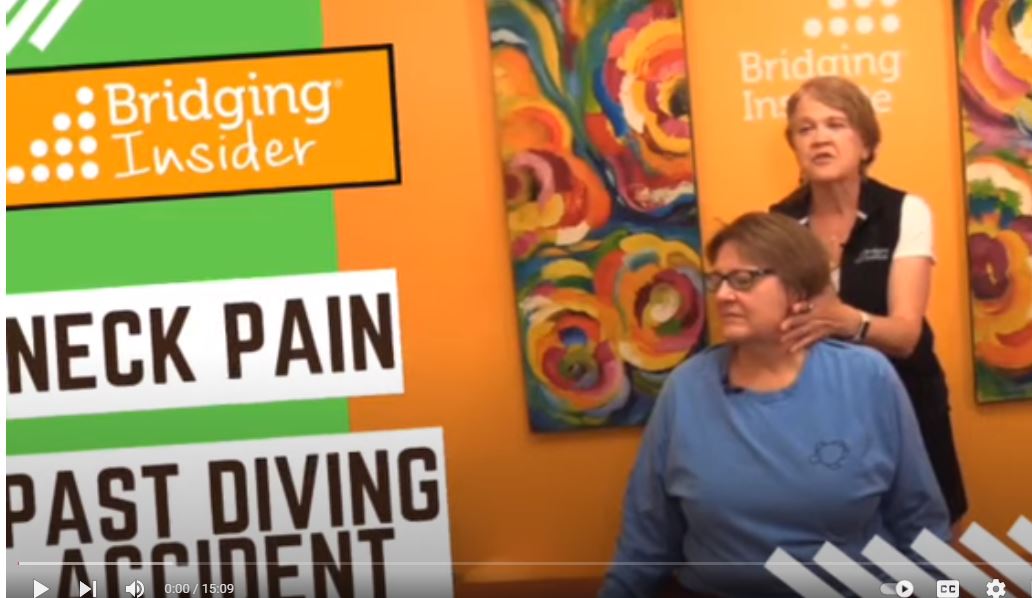Summer, Aquatics, and Head Injuries. The Neck Gets Affected Too! 😞
The theme for this week … head injuries from swimming impact the neck too
Have you bumped your head or gotten your head bumped? Although the impact was to the head, your neck sustained stress too. Getting the neck muscles reset is key to helping you move with less pain and better balance after a head injury. Read on …
How common are head and neck injuries?
Swimming and diving are popular this time of year, especially when the temps soar!
Did you know that head injuries are very common with swimmers? And they happen in a variety of ways, including:
- Slipping on deck
- Bumping into other swimmers
- Bumping into a wall
- Diving
- Dry land training
The following article, “Aquatic Concussions,” asserts that 70% of swimming related injuries involve the head and neck. It’s a short yet insightful read.
We find head injuries also impact the neck
Working with our clients, we find micromovement issues correlate to the specifics of a head injury, and often the neck is most affected (and overlooked!)
Injuries happen so quickly that the precise muscle coordination between the head and shoulders gets disrupted. The neck muscles can be compressed or overstretched, which leaves them generally disorganized. This can result in pain or restricted mobility.
Once we use the Bridging® Technique to reset the micromovement disruptions, your head, neck, or shoulder stress is improved.
In this week’s video session, you’ll see an example of how we were able to reset the compression caused by Joanne’s injury, which occurred many years ago.
Insight of the week from Cara
Often the source of a current pain is something that happened years ago
It’s the time of year when we are outdoors doing what we should be doing … being active!
Unfortunately this sometimes means there are unintended consequences — injuries. Luckily, not all injuries are bad enough for the ER. Yet, sometimes the seemingly less serious ones leave you feeling ‘off’ for a few days and can impact you the most.
Effects of injuries on micromovements
One common type of movement disruptor is an injury/accident. There are two sets of characteristics we look for with injuries — compression, or overstretched.
Compressive injuries
When muscles are compressed they are not able to freely move. Although you may have strength, joint transitions are impacted. Tight shoulders and hips are the most common. You stretch and stretch, but you still have muscle tightness.
Overstretched injuries
Muscles work like paired springs. When an injury is quick and extreme (such as whiplash or a sprain), one “spring” stretches too far, and the other gets crunched up, and they lose their ability to work reciprocally. You perpetually feel off without a clear explanation.
We analyze each of the situations and use the gentle Bridging® reset process to get the muscle groups working together in 1-2 sessions.
Have you had a head injury which impacted your neck and curious if Bridging® can help? Contact us. We are happy to see how we can help.
Stories from our sessions … resetting neck stress from a long-ago injury
Joanne was recently maneuvering a sewing machine, which triggered stress from a prior swimming-related head injury. To help her, we had to re-enact the event to get her neck and shoulders moving again.
Two days later, her update was, “My neck seems much better.”
Two weeks later, her update was “Head is better, no pain behind the ear. Neck almost entirely good. It’s been improving daily …”
What happened to Joanne and when?
Micromovement disrupters
What’s happened to Joanne and when?
Birth/Early life: none
Injury/Accident: head injury age 10
Medical procedures/surgeries: 2 hip replacements, 2 c-sections, multiple minor procedures
Illness: none of note
Using the shoulders to show the head and neck how to move again
Goal: Reset movement between the head, neck, and shoulders to relieve pain from an overuse injury, which triggered symptoms from a prior head injury
What did we find?
We found that Joanne’s head and neck were jammed together and not moving. It impacted the shoulder which was bothering her.
What did we do?
Creatively and gently, we positioned her head forward similar how her head would have hit the pool in the diving incident. Little-by-little her shoulders connected back up to her neck and then head.
You’ll have to watch the video to see how fascinating this example of our technique was! It was definitely an advanced application of using Bridging® to reconnect groups of tiny muscles.

